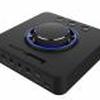Creative Technology has released the the Sound Blaster X3, a sound card featuring the Sound Blaster digital processing technology and game-changing Super X-Fi headphone holography.
The Super X-Fi recreates the soundstage of a surround speaker system in headphones, and personalizes it for a natural listening experience. First unveiled at CES 2019, the Sound Blaster X3 is a high-resolution, 7.1 multi-channel USB DAC, offering up to 32-bit / 192 kHz playback, and features a headphone amplifier capable of driving studio-grade headphones. Besides offering 7.1 discrete channel output, this external sound card also offers 7.1 virtualization on just 2 speakers. It also features Dolby Digital Live encoding for connecting optically to external receivers for multi-channel speakers. Furthermore, users are able to take advantage of Sound Blaster's surround virtualization technology that can be fully customized towards their needs, as personalized EQ presets. With the new Audio Balance feature on Sound Blaster X3, the volume feed can be toggled between two audio sources with a simple turn of the knob. This is a nifty function for PC and Mac users who like to chat while watching movies or playing games, or prefer listening to their favorite songs while gaming.
The Sound Blaster X3 is offering cross-platform compatibility for PC, Mac, PS4 and Nintendo Switch. It is supported by the new Sound Blaster Command software for desktops, and a corresponding mobile app to save console users the hassle of switching to desktops for control and customization.
Sound Blaster X3 is priced at SGD 189 (€124.99) and is available on Creative.com.
Specifications
- Weight:330g
- Dimensions: 129 mm x 129 mm x 40.6 mm
- Dynamic Range (DNR): 115 dB
- Direct Mode:
- Playback Resolution (Stereo): PCM 16-bit, 48.0, 96.0, 192.0 kHz
- Playback Resolution (Stereo): PCM 24-bit, 48.0, 96.0, 192.0 kHz
- Playback Resolution (Stereo): PCM 32-bit, 48.0, 96.0, 192.0 kHz
- Playback Resolution (Optical Out): PCM 16-bit, 48.0, 96.0, 192.0 kHz
- Playback Resolution (Optical Out): PCM 24-bit, 48.0, 96.0, 192.0 kHz
- Surround 7.1: PCM 16-bit, 48.0, 96.0, 192.0 kHz
- Surround 7.1: PCM 24-bit, 48.0, 96.0, 192.0 kHz
- Surround 7.1: PCM 32-bit, 48.0, 96.0, 192.0 kHz
- Dolby Digital Live: 16-bit, 48.0 kHz
- Recording Resolution
- Mic-in: 16-bit, 48.0, 96.0, 192.0 kHz
- Mic-in: 24-bit, 48.0, 96.0, 192.0 kHz
- What-U-Hear: 16-bit, 48.0, 96.0, 192.0 kHz
- What-U-Hear: 24-bit, 48.0, 96.0, 192.0 kHz
- Line-in: 16-bit, 48.0, 96.0, 192.0 kHz
- Line-in: 24-bit, 48.0, 96.0, 192.0 kHz
- Connectivity Options (Main): 1 x TOSLINK Optical Out, 1 x 1/8″ Rear Out, 1 x 1/8″ Center / Sub Out, 1 x 1/8″ Headphone / Headset Jack, 1 x 1/8″ Ext. Mic-in Jack, 1 x ⅛″ Front-out, 1 x ⅛″ Side Out Jack, 1 x USB Type-C port for PC / Mac, 1 x ⅛″ Line-in Jack
- Headphone Amp: Supported Headphone Impedance: 32Ω - 600Ω, Low Gain: 32 - 149Ω (1.2V RMS @ 32Ω, 1.5V RMS @ 150Ω), High Gain: 150 - 600Ω (2.3V RMS @ 150Ω, 2.9V RMS @ 600Ω)
- Supported Operating Systems: Windows 7, Windows 8.1, Windows 10
- DAC: Dynamic Range (Stereo): 115 dB, THD+N (Stereo): 0.0004%
- ADC: Dynamic Range: 104 dB, THD+N: 0.0017%
- Power: USB Bus Powered, USB Type-C
- System Requirements
- Windows OS
- Intel Corei3 or AMD equivalent processor
- Intel, AMD, or 100% compatible motherboard
- Microsoft Windows 10 32 / 64-bit, Windows 8.1 / 8.0 32 / 64-bit, Windows 7 32 / 64-bit
- 1 GB RAM
- > 600 MB of free hard disk space
- USB 2.0 / USB 3.0 port
- Mac OS
- Mac OS X 10.9 or higher
- 1 GB RAM
- USB 2.0 / USB 3.0 port
- PS4
- Firmware Ver 5.0 or later
- Available USB port
- Nintendo Switch
- Switch OS 5.0 or later
- Available USB port (in docking mode)
- External USB Power (not included)
- Voice communications is title dependent
- Android
- Android OS Ver 7.0 or later
- Device must have built-in Bluetooth Low Energy (BLE) support
- iOS
- iOS Ver 11.0 or later
- Device must have built-in Bluetooth Low Energy (BLE) support
- Windows OS


